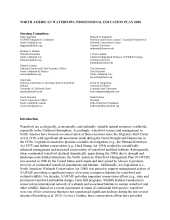
Introduction
Waterfowl are ecologically, economically, and culturally valuable natural resources worldwide, especially in the Northern Hemisphere. Accordingly, waterfowl science and management in North America have focused on conservation of these resources since the Migratory Bird Treaty Act in 1918, with significant advancements made during the Great Drought and Depression in the 1930s. Legislation enacted to promote scientific investigations (e.g., the Pittman-Robertson Act 1937) and habitat conservation (e.g., Duck Stamp Act 1934) resulted in scientifically informed management and increased conservation of waterfowl and their habitats. Subsequently, when continental waterfowl declined dramatically again during the 1980s due to drought and landscape-scale habitat alterations, the North American Waterfowl Management Plan (NAWMP) was enacted in 1986 by the United States and Canada and later joined by Mexico to promote recovery of continental waterfowl populations and habitats. Additionally, key legislation (i.e., North American Wetlands Conservation Act 1988) was passed to support management actions of NAWMP, providing a significant source of revenue to improve habitats for waterfowl and wetland wildlife. For decades, NAWMP and other important conservation efforts (e.g., state and provincial waterfowl and habitat stamps, Farm Bill programs, Wildlife Habitat Canada) have conserved an international network of wetlands and associated habitats to sustain waterfowl and other wildlife. Indeed, in a recent assessment of status of continental bird species, waterfowl were one of few avian taxa that have not experienced significant declines during the last several decades (Rosenberg et al. 2019; Science). Further, these conservation efforts have provided broad societal and natural benefits including recharging groundwater, reducing flooding, sequestering carbon, improving water quality, enabling pollination of flora and crops, as well as providing places for people to recreate.
Management and conservation neither progress effectively nor efficiently without trained professionals to study and steward natural resources. In the early 2000s, published research revealed that university-based waterfowl programs were declining in North America. By 2013, > 40% of these programs were lost after faculty retired or passed, and their positions were not filled with experts in waterfowl because of funding limitations or transition toward conservation of biodiversity rather than foci on game species (Kaminski 2013; The Wildlife Professional). Accordingly, the waterfowl community questioned who would educate and produce skilled waterfowl scientists and stewards to sustain waterfowl populations.
Additionally, simply encouraging university, college, and other educational partners to graduate students with skills in waterfowl and wetland science and management may not be proactive or adequate. Thus, the NAWMP community also must recognize and promote values of an inclusive workforce that reflect an increasingly multicultural and diverse North American society and welcome professionals from historically underrepresented backgrounds. Inclusion, diversity, and engagement must be an intentionally sustained mission that pervades the strategic objectives and implemented practices of conserving waterfowl. The 2012 NAWMP Revision and 2018 NAWMP Update identified the importance of championing the diverse ecosystem benefits of wetland and waterfowl conservation and to engage broader segments of society. Professionals must be aware of and consider the human-dimensional aspects related to advancing waterfowl science to guide conservation of waterfowl, other wetland wildlife, and ecosystems upon which they depend. The continued relevance of NAWMP hinges upon engagement and inclusive diversity among the professionals and recreational participants who value and support North American waterfowl conservation (USFWS Diversity and Inclusion Implementation/Action Plan 2015, Association of Fish and Wildlife Agencies [AFWA] and Wildlife Management Institute’s [WMI] Fish and Wildlife Relevancy Roadmap). Thus, we strongly encourage educational institutions to recruit, train, and promote a diverse workforce in natural resources for the future. Further, efforts are needed by agencies and organizations to stimulate and encourage interest in the wildlife profession across all segments of society well before the college years to achieve diversity goals of all natural-resource specializations, including waterfowl conservation.
Within North America, language can present a barrier to the full range of educational and work opportunities and may limit human inclusivity in the waterfowl profession. Canada has two official languages (English and French). Incomplete translation of educational materials may limit the opportunities for francophone Canadians to access resources produced at primarily anglophone educational institutions and vice versa. In Mexico, universities have excellent graduate programs in the biological sciences, but lack programs focused on wildlife management and specifically on waterfowl and wetland management. To receive this specialized training, students presently matriculate to universities in the United States. However, entrance examinations and most coursework are in English only. This dilemma presents a substantial barrier to many Spanish-speaking students who are not bilingual.
The 2018 Update of NAWMP identified the critical need to maintain and expand educational capacity to ensure existence of an appropriately skilled workforce to meet the conservation goals of the Plan. Its Recommendation 7 reads, “Bolster training programs for future waterfowl management professionals.” Thus, the waterfowl management community promoted efforts on this front, and, in February 2020, the NAWMP Committee endorsed a new initiative termed the North American Waterfowl Professional Education Plan (NAWPEP). As with NAWMP, we recognize that waterfowl populations are dependent upon conservation of wetland and upland habitats, and thus we recognize that the education programs referenced by NAWPEP must include focus on the scientific understanding of these habitat systems. Herein, we outline a strategic plan with an explicit goal and objectives to sustain and grow university- and college-based waterfowl academic and experiential programs in North America. We recommend revisiting this plan at 5-year intervals.
Download the full document below.
